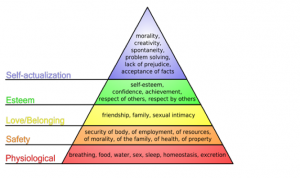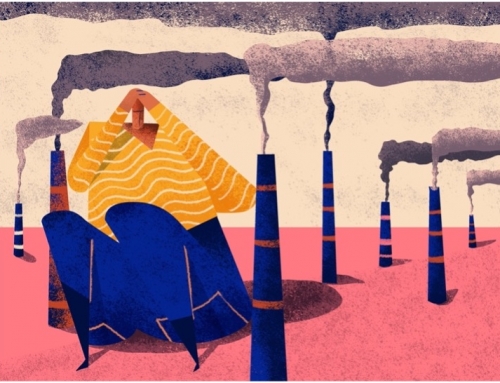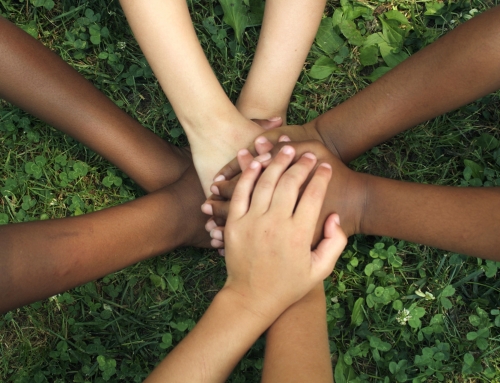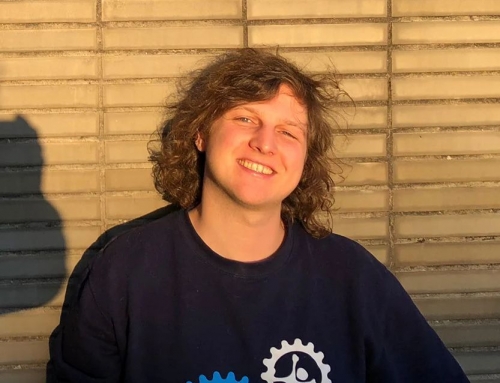6-04-2020
Introduction
In the previous blog, I wrote about the world pandemic that is going on right now and how important it is that we adapt to what is happening and do our best to remain healthy. A virus like this has major consequences, of course, but we have to make sure that we don’t go crazy and that we look after ourselves, and each other. In this blog, I would like to elaborate on this and apply Maslow’s pyramid to the pandemic and reflect on how much of an impact this period has on all of us.
The only way is up
Maslow’s hierarchy of needs shows the needs of people in order to come to the top of the created pyramid, which is self-actualization. Maslow tried to focus on the things that make people happy and what people do to become happy. He had the thought that people have an inborn desire to be self-actualized, which means that they want to be all that they can be (Cherry, 2019). However, to become this best version of themselves, a few basic needs must be met.

retrieved from: Wiki Commons
The needs are illustrated as a pyramid where the most basic needs are at the lower bottom and the most complex needs are at the top. Therefore, the basic needs are the psychological requirements such as food and sleep which a person needs to live, with which Maslow naturally wants to indicate that you cannot develop yourself without first taking care of yourself. When a person can keep themselves alive with the basic needs such as sleeping and eating, we come to the safety part. Here, Maslow shows that a person needs security. A person should be healthy, needs a job for their income, and needs to generally ensure that their lives are safe enough from collapsing. When all that is under control, someone can settle on relationships to make sure they have people around them. These people can then help with creating self-confidence and showing that is important to respect others and be respected by them to finally reach the top and have self-actualization. Where you have the expression to be creative and create your own mindset in what you believe and find important.
The pyramid and the virus
If we apply the pyramid to the coronavirus, we can see that already a lot has happened. In the first weeks of the pandemic where, as a society, we had to adjust our lifestyles and follow measures such as staying at home, sneezing in the elbow, washing hands, etc. we were completely at the bottom of the pyramid. Everyone fell back to the important need to pay extra attention to their health. It was announced that the virus would mainly affect people with a poor immune system, so several people went to eat extra healthy food to make it easier for their bodies to shed the virus. Also, everyone started stocking up food (Parool, 2020). The psychological need to keep yourself alive and to have enough food was additionally adjusted. People frightened each other and everyone withdrew to the basic need where they just wanted to stay alive and create safety for themselves.
Now, we are a few weeks later. The panic of the first weeks has reversed and most people have been able to adapt to the new lifestyle where we have to stay at home as much as possible. We calmly go up again to the pyramid but notice that the third layer is perhaps the most difficult as we are currently not allowed to have much social contact. It is noticeable that people really need this third layer in a situation like this, where we want to seek support from each other. “Human contact is almost as essential as water or food. Especially in times of uncertainty, fear and stress, interaction with people is essential. Other people form a buffer against reality, we feel safe in a group. If it disappears, we feel threatened.” (Lange, 2020). Fortunately, we have the technology where we can still communicate with one another. For example, many people are now very active via Skype, Zoom and Microsoft Teams. In addition to online work meetings, these platforms are now also used for Friday afternoon drinks and coffee moments to catch up with each other and to keep the social contact going (Dirks & Kraak, 2020). Moving us further up the pyramid where we are contacting with each other, but also being creative and adjusting to what is happening around us.
With the many free time that we now have because of our staying at home lifestyle, people also have the opportunity to apply their creativity and finally start doing things that were previously not possible because of other things that had priority. For example, a huge number of families have now started working on the house or in the garden, which were the chores that were first put aside and are suddenly all being done because of the many free time they must spend at home. Next to that, new innovative things such as live stream parties for young people at home are devised to make something out of this entire experience. Besides, people also embark on a hobby like painting, because they now have so much time left. This then brings many people back to the top of the pyramid, where they have accepted the situation and are trying to make the most out of it.
I think this entire virus has created a whole new process of self-actualizing, which we eventually managed to master quite well, but is still an on-going cycle. For example, there is still much unclear, and we also have a lot to deal with fake news, which does not always reassure us. To illustrate, for a while a WhatsApp message went around saying that if you could hold your breath for 10 seconds without any problems, you didn’t have corona. Everyone was reassured until it later turned out that this was fake news (MELDPUNT, 2020). At first, people were back to the safety of their health with the message and started to seek more social contact. After the fake news, people fell back to the fear that they might have the virus after all and back to the layer of health and safety. Therefore, technology is an advantage for our social contact, but not always the best tool against our health.
What to do?
I hope this pyramid can provide some structure for the people. As I said in my previous blog, there are still many people who have mental health problems at a time like this and who have trouble finding a structure for themselves. There are, for example, problems at home or they cannot control their negative thoughts and there are still many people living in fear. This pyramid is hopefully a tool. Also for the GGD. As a health organization, it is especially important for the GGD to help people get through the second layer. Some people can do this themselves, others have more difficulty with this. Because in addition to health, the second layer also involves certainty. Some people have enormous financial problems with this crisis and even an opportunity to lose their jobs. This can do a lot mentally. The GGD cannot give people back their jobs, but possibilities to talk about this, to think along with them, are already major steps to get them through this. Hopefully, the pyramid is a good overview and perhaps even a simple reminder of what is so important to us human beings, especially at a time like this. But I guess that I can speak for many when I say that the whole situation is a big emotional rollercoaster.
For my societal challenge to ensure that mental health problems become a topic that people dare to talk openly about and admit when they are having a hard time, Maslow’s pyramid is very appropriate. It shows us again how important it is that we are healthy and how we need security. But it also gives me clarity in each case. Knowing what is important for people to be mentally healthy. Somehow it is also a contrast. We must be in good health before we can make social contacts, but sometimes our social contacts can actually help with our health. My next blog will be about the Life Cycle and how we as a person would like to seek control, while that is not always the most sensible. But also for the GGD, how in a crisis like this it is important to make transformation, instead of looking for balance. I will also involve an expert from the GGD to get their insights.
References
Cherry, K. (2019, December 3). what is maslows hierarchy of needs. Retrieved from verywellmind: https://www.verywellmind.com/what-is-maslows-hierarchy-of-needs-4136760
Dirks, B., & Kraak, H. (2020, April 1). borrels en koffiemomenten zijn nu virtueel hoe thuiswerkers de dagen doorkomen. Retrieved from volkskrant: https://www.volkskrant.nl/nieuws-achtergrond/borrels-en-koffiemomenten-zijn-nu-virtueel-hoe-thuiswerkers-de-dagen-doorkomen~b566fb78/
ggdwestbrabant. (2020, January 27). over de ggd. Retrieved from ggdwestbrabant: https://www.ggdwestbrabant.nl/over-de-ggd
Lange, P. v. (2020, March 13). De psychologie van thuisblijven dit doet sociale isolatie met ons. Retrieved from volkskrant: https://www.volkskrant.nl/nieuws-achtergrond/de-psychologie-van-thuisblijven-dit-doet-sociale-isolatie-met-ons~be4aecaf/
MELDPUNT. (2020, March 26). corona-adviezen-via-whatsapp. Retrieved from maxmeldpunt: https://www.maxmeldpunt.nl/gezondheid/corona-adviezen-via-whatsapp/
Parool, h. (2020, March 23). 40 procent van de nederlanders blijft hamsteren. Retrieved from parool: https://www.parool.nl/nederland/40-procent-van-de-nederlanders-blijft-hamsteren~b92e624f/
RTLnieuws. (2020, March 18). coroan-coronavirus-nepnieuws-nep-fake-news-covid-19. Retrieved from rtlnieuws: https://www.rtlnieuws.nl/nieuws/nederland/artikel/5060921/corona-coronavirus-nepnieuws-nep-fake-news-covid-19





